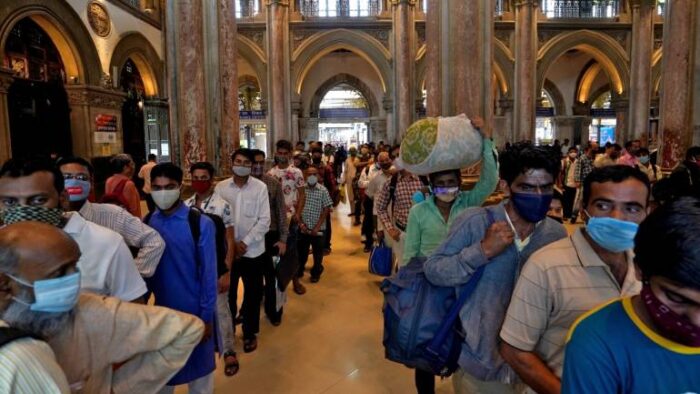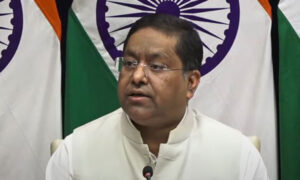
File Picture
The Wuhan virus or better known as the Coronavirus is rising it’s head once again in Maharashtra, Punjab, Jammu and Kashmir and Madhya Pradesh, which has set the alarm bells ringing. With Maharashtra Chief Minister Uddhav Thackeray warning that “a second wave is knocking on the door”. People have been asked to observe precautions or be ready for another lockdown starting March 1. Referring to the rise in cases in the state, including Mumbai and Pune, Thackeray said, “The second wave has not yet come but it is knocking on our door. We will get to know in the next two weeks whether the second wave has come.” The rise in the number of cases in Kerala, Maharashtra, Punjab, Chhattisgarh and Madhya Pradesh comes in the backdrop of five persons, who returned recently to India, being detected with the infectious Covid-19 variants found in South Africa and Brazil.
The rapid rise in cases in Maharashtra now shows that there could still be a fairly large proportion of population that is uninfected, and thus vulnerable to getting infected. The number of cases in Maharashtra had fallen below 2,500 a day by the first week of February, before beginning to rise again. For the last three days, the state has reported more than 6,000 cases. On February 21, it was close to 7,000. Such high numbers were last seen in October. Maharashtra has re-imposed strict restrictions in five of its districts — Amravati, Akola, Yavatmal, Buldana and Washim — with a “partial lockdown” in two of them. The Maharashtra government had said that one sample in Amaravati was detected with the E484K mutation that has been found in the fast spreading South African, UK and Brazilian variants.
Amid the surge, neighbouring state Karnataka issued an order making it mandatory for people arriving from Maharashtra to be in possession of a negative RT-PCR report “that is not older than 72 hours” prior to arrival in the state. Earlier this week, Karnataka’s Health Department had issued a similar order for those arriving from Kerala. Dr V K Paul, Member, NITI Aayog, had said the emergence of the two variants in the country was a matter of concern. He said, “This virus has not gone away. It is still affecting our population and can raise the number of cases. This is a concern….we already have a UK variant in our country. Hopefully, these variants will not cause a catastrophic situation in the country. But it just shows that vigil to contain these disease must continue.” However, the Indian officials maintained that the mutated versions of coronavirus were not responsible for a surge in cases in two states, a potential relief for a country where mask-wearing and physical distancing have largely disappeared.
The spectacular fall in numbers in India for nearly five months, including in the five states that are showing a resurgence now, had led to the belief that the infection levels in the country had probably reached a level of herd immunity. The testing rate had not dropped significantly, lockdown restrictions had been eased, festivals and elections had seen people coming out in large numbers, political activities had restarted, a farmers’ protest had been going on, and the adherence to norms of physical distancing or adoption of masks was not very high. The farmers’ protests, where no one was wearing masks or following physical distancing, seems to be the obvious cause for the surge seen in Punjab, though it is not at all clear why this increase in numbers did not happen in November, December or January. Compared to Maharashtra, the numbers in Punjab are not very high, less than 400 a day right now, but the state had started to report well below 200 cases a day by the middle of January. In fact, the rise in cases in Punjab has not been as sudden or steep as in Maharashtra. The state has been finding more than 200 new cases for over ten days now, but in the last three days, the count has been more than 350.
So, despite the lack of corroborative data from serosurveys, there were suggestions that a large proportion of the population could already have been infected, far beyond the numbers that have been detected through testing, and that is what was resulting in the steady decline in numbers. There is no particular point of infection level in the community after which the effects of herd immunity start to kick in. In general, once more than 40 to 50 per cent of the population group has got infected, there is a noticeable slowdown in the further spread of the disease, mainly because the number of uninfected people, who can potentially get infected, is considerably less than earlier.
The ministry’s data shows that five states account for 78.22 per cent of the new deaths: Maharashtra has seen more than 44 casualties, Kerala 15, Punjab 8, Tamil Nadu 7 and Karnataka 5 deaths. The top five states in terms of number of active cases are: Kerala (60,087), Maharashtra (45,957), Karnataka (5,901), Tamil Nadu (4,147) and West Bengal (3,625).
India has administered nearly 12 million vaccine doses to its health and frontline workers since beginning the campaign in mid-January, a pace that will have to be increased sharply to meet the target of reaching 300 million people by August. Health Secretary Rajesh Bhushan said, “India would very soon start immunising people over 50 and those with medical conditions, with greater involvement from private hospitals.”
[the_ad id=’22722′]


















